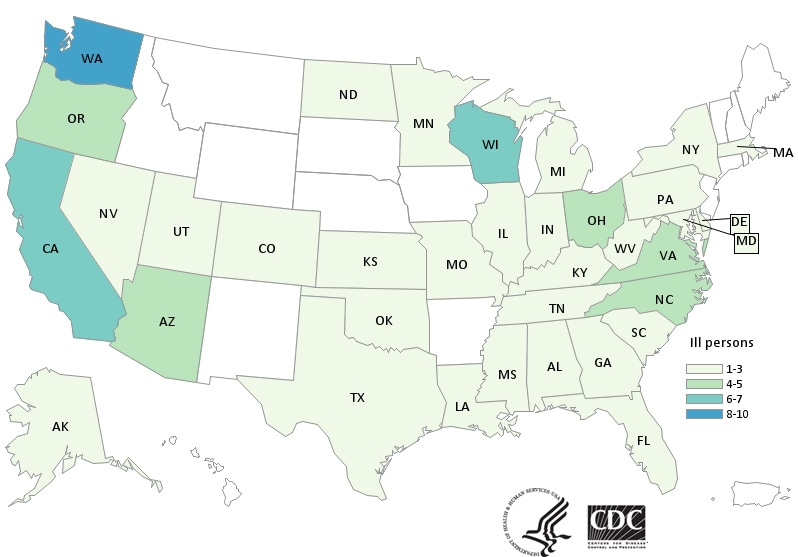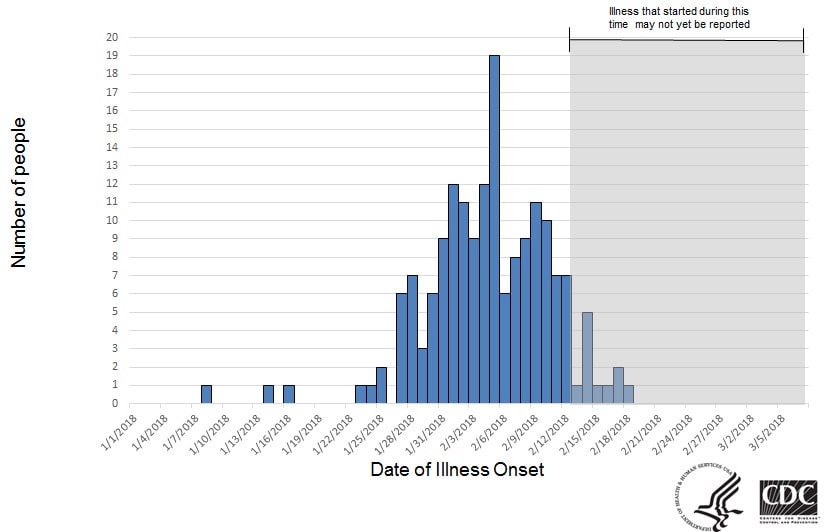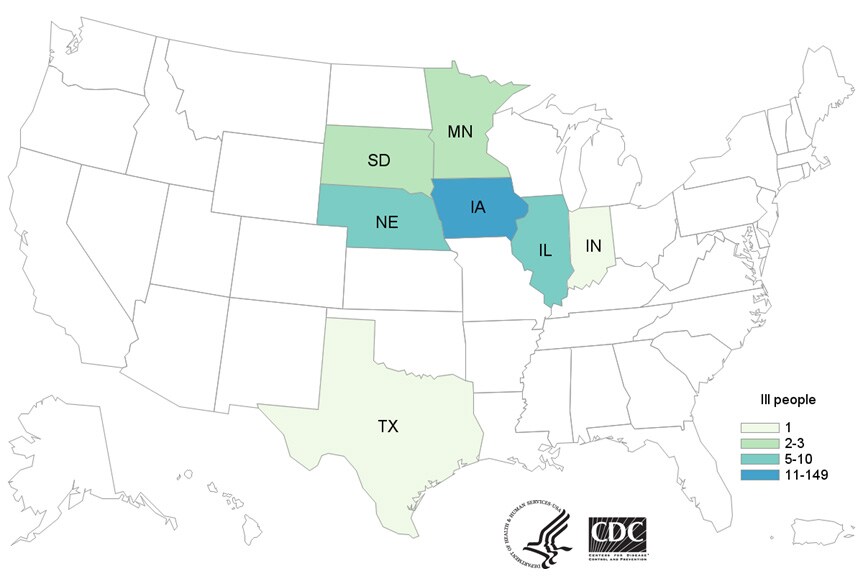Archive for the ‘Food-borne diseases’ Category
1 Death from the Multistate Outbreak of E. coli O157:H7 Infections Linked to Romaine Lettuce
Thursday, May 3rd, 2018As of May 1, 2018, 121 people infected with the outbreak strain of E. coli O157:H7 have been reported from 25 states…..Illnesses started on dates ranging from March 13, 2018 to April 21, 2018. Ill people range in age from 1 to 88 years, with a median age of 29. Sixty-three percent of ill people are female. Of 102 people with information available, 52 (51%) have been hospitalized, including 14 people who developed hemolytic uremic syndrome, a type of kidney failure. One death was reported from California.…”
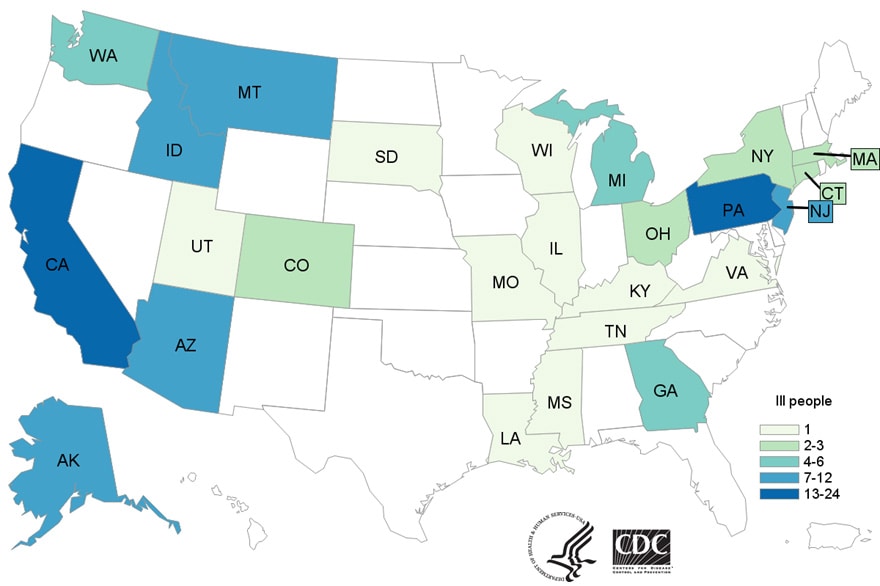
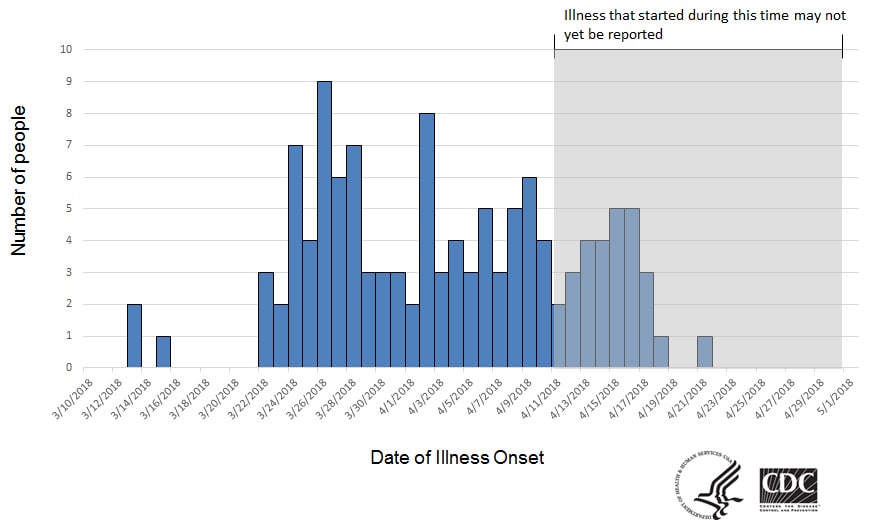
CDC: Multistate Outbreak of E. coli O157:H7 Infections Linked to Chopped Romaine Lettuce
Saturday, April 14th, 2018Case Count Update
Since the last update on April 10, 2018, 18 more people from 9 states were added to this outbreak.
As of April 12, 2018, 35 people infected with the outbreak strain of E. coli O157:H7 have been reported from 11 states. A list of the states and the number of cases in each can be found on the Case Count Map page. Illnesses started on dates ranging from March 22, 2018 to March 31, 2018. Ill people range in age from 12 to 84 years, with a median age of 29. Sixty-nine percent of ill people are female. Twenty-two ill people have been hospitalized, including three people who developed hemolytic uremic syndrome, a type of kidney failure. No deaths have been reported.
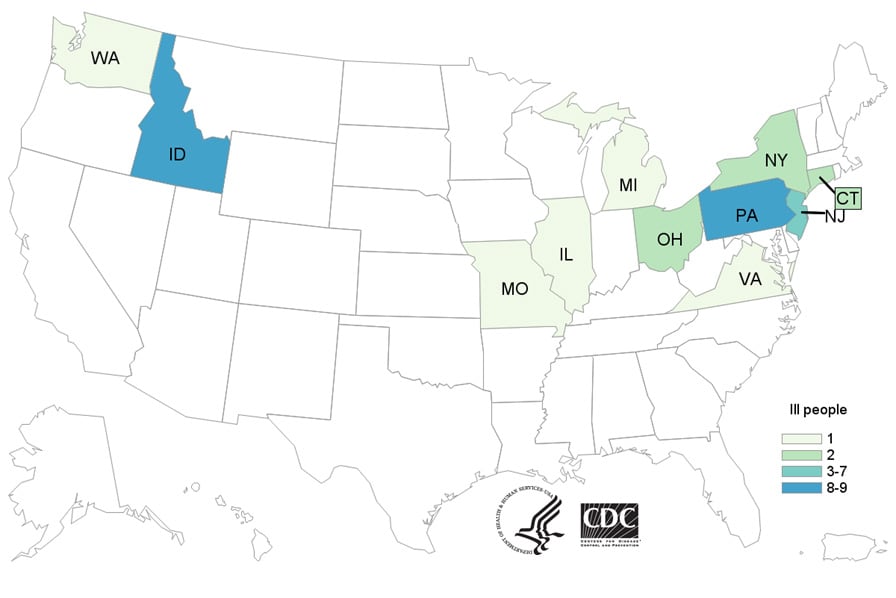
Illnesses that occurred after March 27, 2018, might not yet be reported due to the time it takes between when a person becomes ill with E. coli and when the illness is reported. This takes an average of two to three weeks.
The current outbreak is not related to a recent multistate outbreak of E. coli O157:H7 infections linked to leafy greens. People in the previous outbreak were infected with a different DNA fingerprint of E. coli O157:H7 bacteria.
Investigation Update
Epidemiologic evidence collected to date indicates that chopped romaine lettuce is the likely source of this outbreak. Twenty-six (93%) of 28 people interviewed reported consuming romaine lettuce in the week before their illness started. This percentage is significantly higher than results from a survey[787 KB] of healthy people in which 46% reported eating romaine lettuce in the week before they were interviewed. Most people reported eating a salad at a restaurant, and romaine lettuce was the only common ingredient identified among the salads eaten. The restaurants reported using bagged, chopped romaine lettuce to make salads. At this time, ill people are not reporting whole heads or hearts of romaine.
Traceback investigations are ongoing to determine the source of chopped romaine lettuce supplied to restaurant locations where ill people ate. At this time, no common grower, supplier, distributor, or brand has been identified. However, preliminary information indicates that the chopped romaine lettuce was from the Yuma, Arizona growing region.
Information collected to date indicates that chopped romaine lettuce from the Yuma, Arizona growing region could be contaminated with E. coli O157:H7 and could make people sick. Read CDC’s advice to consumers, restaurants, and retailers.
This investigation is ongoing, and CDC will provide more information as it becomes available.
Indonesia: 82 Indonesians have died and many more have been hospitalized after drinking tainted bootleg liquor
Wednesday, April 11th, 2018CDC has now confirmed 132 cases in 32 states tied to the use of kratom, an herbal alternative to opioids.
Saturday, April 7th, 2018What’s New?
- Forty-five more ill people from 19 states were added to this investigation since the last update on March 15, 2018.
- Three additional states have reported ill people: Connecticut, Iowa, and Idaho.
Highlights
- At this time, CDC recommends that people not consume any brand of kratom in any form because it could be contaminated with Salmonella.
- Kratom products from several companies have been recalled because they might be contaminated with Salmonella. The list of recalled kratom products is available on the U.S. Food and Drug Administration website.
- Kratom is also known as Thang, Kakuam, Thom, Ketom, and Biak.
- Kratom is a plant consumed for its stimulant effects and as an opioid substitute.
- CDC, public health and regulatory officials in several states, and the U.S. Food and Drug Administration are investigating a multistate outbreak of Salmonella infections.
- Epidemiologic and laboratory evidence indicates that kratom is the likely source of this multistate outbreak.
- No common brands or suppliers of kratom products have been identified at this time.
- Because no common source of Salmonella-contaminated kratom has been identified, CDC is recommending against consuming any kratom.
- A total of 132 people infected with outbreak strains of Salmonella I 4,[5],12:b:- (61), Salmonella Javiana (15), Salmonella Okatie (21), or Salmonella Thompson (35) have been reported from 38 states.
- Forty percent of ill people have been hospitalized, and no deaths have been reported.
- This investigation is ongoing. CDC will provide updates when more information is available.
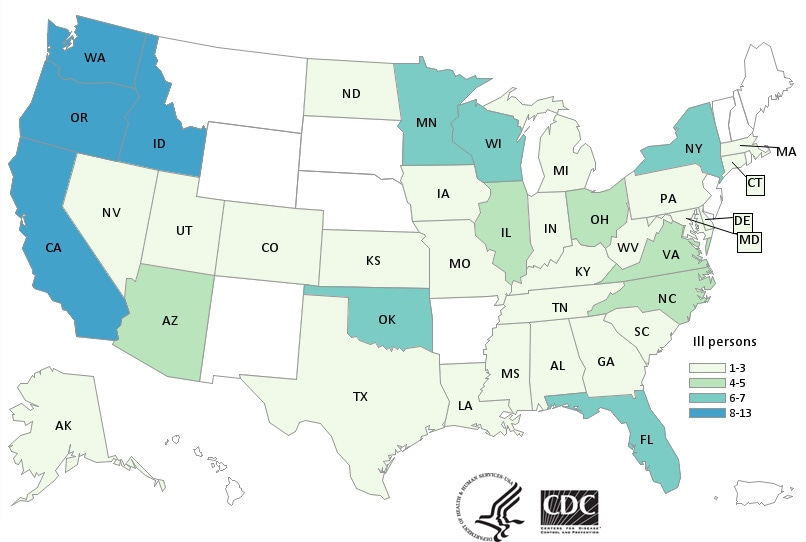
South Africa: The world’s largest known listeria outbreak and it was all due to tainted baloney!
Monday, April 2nd, 2018The world’s largest known listeria outbreak has spread throughout South Africa for 15 months, killing 189 people. Health officials believe they have identified the source: bologna.
Since January last year, 982 confirmed cases of listeriosis had been recorded, the National Institute for Communicable Diseases in South Africa reported on Thursday. The infection, caused by food that has been contaminated with the bacterium Listeria monocytogenes, is often lethal.
A cluster of gastroenteritis cases among toddlers in a Johannesburg hospital this January led authorities to the sandwich meat in a day care center’s refrigerator — and in turn, to a meat production facility in the northern city of Polokwane. There, officials said they detected traces of LST6, the listeria strain identified in 91 percent of the outbreak’s cases.
https://www.youtube.com/watch?v=leGp7QMnBZk
A multistate Salmonella outbreak linked to kratom supplements has sickened 47 more people and expanded to 8 more states, raising the total to 87 cases from 35 states,
Tuesday, March 20th, 201814 people, including four children, were hospitalized after a mass botulism food poisoning outbreak in southern Kyrgyzstan.
Thursday, March 15th, 2018Multistate Outbreak of Salmonella Typhimurium Linked to Chicken Salad
Friday, March 9th, 2018South Africa: A factory operated by Enterprise Foods in Polokwane in Limpopo is the source of a listeria outbreak that has killed 180 people in the past year
Monday, March 5th, 2018‘…..”Avoid all processed meat products that are sold as ready to eat‚” Health Minister Aaron Motsoaledi told journalists at the National Institute of Communicable Diseases (NICD) on Sunday afternoon…..’

Chicken Salad & The Case of the Multistate Outbreak of Salmonella Typhimurium
Saturday, February 24th, 2018- CDC recommends people do not eat recalled chicken salad sold at Fareway grocery stores. Throw it away or return it to the place of purchase.
- On February 21, 2018, Triple T Specialty Meats, Inc. recalled all chicken salad produced from January 2, 2018 to February 7, 2018.
- The recalled chicken salad was sold in containers of various weights from the deli at Fareway grocery stores in Illinois, Iowa, Minnesota, Nebraska, and South Dakota from January 4, 2018 to February 9, 2018.
- Even if some of the chicken salad was eaten or served and no one got sick, throw the rest of it away. Put it in a sealed bag in the trash so that children, pets, and other animals can’t eat it.
- Wash and sanitize countertops as well as drawers or shelves in refrigerators or freezers where recalled chicken salad was stored.
- If you don’t remember the date when you purchased chicken salad from Fareway, don’t eat it. Throw it away or return it to the place of purchase.
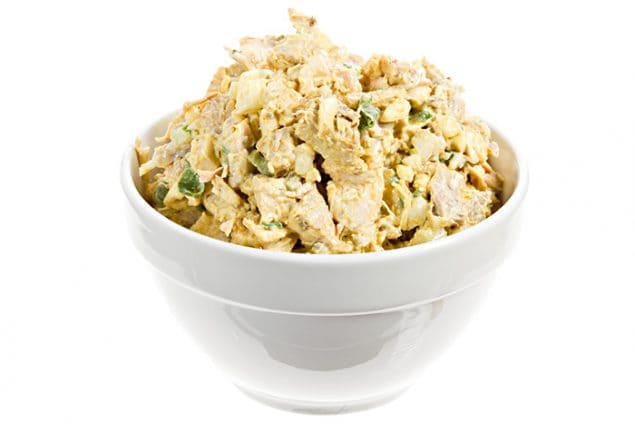
- CDC, public health and regulatory officials in several states, and the U.S. Department of Agriculture’s Food Safety and Inspection Service are investigating a multistate outbreak of Salmonella Typhimurium infections.
- Epidemiologic and laboratory evidence indicates that chicken salad produced by Triple T Specialty Meats, Inc. and sold at Fareway grocery stores is the likely source of this multistate outbreak.
- Sixty-five people infected with the outbreak strain of Salmonella Typhimurium have been reported from five states.
- Twenty-eight hospitalizations have been reported.
- No deaths have been reported.
- This investigation is ongoing. CDC will provide updates when more information is available.
![People infected with the outbreak strain of Salmonella I 4,[5],12:b:-, by state of residence, as of February 16, 2018](https://www.cdc.gov/salmonella/typhimurium-02-18/images/map/big-map-2-21-18.jpg)



